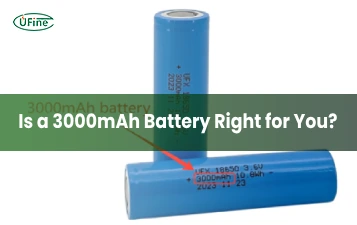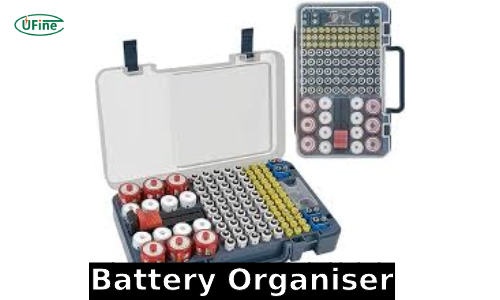Do you want to dig through drawers and cabinets to find the correct battery? An efficient battery storage system can save you time and frustration, whether for your TV remote, children’s toys, or your favorite gadgets. This comprehensive guide will explore five creative ways to organize your batteries and keep your home clutter-free. Let’s dive in!
Part 1. 5 Innovative battery organizer ideas
Organizing your batteries doesn’t have to be a hassle. Here are five innovative solutions to keep your batteries neatly stored and easily accessible:
- Battery Storage Boxes with Built-in Tester
- DIY Battery Organizer
- Drawer Dividers
- Wall-Mounted Battery Storage
- Battery Storage Cases
1. Battery Storage Boxes with Built-in Tester: Convenience and Functionality
Battery storage boxes with built-in testers are a multifunctional solution for organizing and maintaining your batteries. These boxes not only help you keep your batteries neatly stored but also allow you to test their charge. Here are some benefits of using battery storage boxes with built-in testers:
- Convenience: Easily check the charge level of your batteries without needing a separate tester.
- Organization: These boxes typically come with compartments for different battery sizes, keeping everything in place.
- Space-Saving: Designed to be compact, they help you save space while keeping your batteries accessible.
When choosing a storage box with a built-in tester, look for a durable and clear lid. This feature lets you see what’s inside without opening the box, making it easy to find the battery you need.
2. DIY Battery Organizer: Custom Solutions for Your Needs
If you enjoy hands-on projects, consider creating a DIY battery organizer. This approach allows you to customize your storage solution based on your needs. Here are a few ideas to get you started:
- Wooden Battery Holder: Craft a wooden holder with compartments for different battery sizes. You can use plywood or repurpose old wooden boxes.
- PVC Pipe Organizer: Cut PVC pipes to the desired length and glue them together to create a custom battery holder. This method is perfect for organizing batteries in a drawer or shelf.
- Magnetic Strips: Attach magnetic strips to a board and stick your batteries to the magnets. This solution works well for smaller batteries like AA and AAA.
Creating your battery organizer can be fun and rewarding, giving you a sense of accomplishment and a perfectly tailored storage solution.
3. Drawer Dividers: Tidy Up Your Battery Drawer
A common place to store batteries is in a drawer, but it can quickly become a jumbled mess. Drawer dividers are an excellent way to keep your batteries organized and easily accessible. Here’s how to implement this solution:
- Measure Your Drawer: Determine the dimensions of your drawer and the sizes of the batteries you need to store.
- Choose Your Dividers: You can buy adjustable dividers or make your own from cardboard, plastic, or wood.
- Sort Your Batteries: Arrange your batteries by type and size, placing each group in its designated compartment.
Drawer dividers keep your batteries organized and prevent them from rolling around and mixing up with other items.
4. Wall-Mounted Battery Storage: Save Space and Stay Organized
Consider wall-mounted storage solutions if you need more drawer or shelf space. These organizers free up valuable space while keeping your batteries within easy reach. Here are a few ideas:
- Pegboard Organizer: Install a pegboard on your wall and use hooks or small baskets to hold your batteries. This highly customizable method allows you to adjust the layout as needed.
- Hanging Pockets: Use a hanging shoe organizer with clear pockets to store your batteries. This solution works well in a utility room or garage.
- Magnetic Strips: Similar to the DIY organizer mentioned earlier, magnetic strips can be mounted on the wall to hold your batteries.
Wall-mounted storage is an efficient way to keep your batteries organized, mainly if you have limited space in your home.
5. Battery Storage Cases: Keep Different Types Separate
Battery storage boxes are another practical solution for organizing your batteries. These boxes come in various sizes, and users can label them to make them easy to identify. Here’s how to use storage boxes effectively:
- Label Each Box: Clearly label each box with the type of battery it contains (e.g., AA, AAA, C, D, 9V).
- Stackable Design: Choose boxes that can be stacked to save space in your cabinets or shelves.
- Clear Lids: Opt for boxes with clear lids to quickly see what’s inside without opening them.
Storage boxes are ideal for keeping your batteries organized and easily accessible, reducing the time you spend searching for the right one.
Part 2. Top brands and models of battery organizers
Several brands offer high-quality battery organizers. Here are some top options:
- Battery Daddy: Known for its compact and portable design, this organizer can hold up to 180 batteries and includes a built-in tester.
- Storacell: Offers a variety of compact and durable organizers that are perfect for home use and travel.
- Range Kleen: Features wall-mounted drawer inserts designed to store and organize batteries efficiently.
- The Battery Organizer: A popular choice with a clear lid and built-in tester, holding up to 93 batteries.
Part 3. Tips for storing batteries safely
Since you have a few creative ways to organize your batteries, storing them safely is essential. Here are some tips to ensure your batteries stay in good condition:
- Avoid Extreme Temperatures: Store your batteries in a cool, dry place. Extreme heat or cold can reduce their lifespan.
- Keep Batteries Separate: Store batteries of different types and brands separately to prevent chemical reactions.
- Check Expiration Dates: Regularly check your batteries for expiration dates and dispose of any past their prime.
- Avoid Metal Containers: Storing batteries in metal containers can lead to short-circuiting. Opt for plastic or cardboard storage solutions instead.
- Store Batteries in Original Packaging: Keep batteries in their original packaging until you need to use them. This helps prevent contact with other batteries and reduces the risk of short circuits.
- Keep Away from Children: Store batteries that are out of reach for children. Ingested batteries can cause severe injury or even be life-threatening.
- Don’t Mix New and Old Batteries: Mixing new and old device batteries can lead to leakage or rupture. Always replace all batteries in a device at the same time.
Part 4. Eco-friendly battery disposal
Proper disposal of batteries is crucial for environmental protection. Here are some eco-friendly tips for disposing of your used batteries:
- Recycle: Many types of batteries, including rechargeable batteries and car batteries, can be recycled. Check with your local recycling center for guidelines.
- Battery Collection Programs: Some retailers and community centers offer battery collection programs. Look for drop-off points in your area.
- Avoid Landfills: Never dispose of batteries in regular trash. Batteries contain harmful chemicals that can leach into the soil and water, causing environmental damage.
- Household Hazardous Waste Facilities: Many communities have facilities that handle household hazardous waste, including batteries. Contact your local waste management authority for information.
Part 5. Benefits of organizing your batteries
Organizing your batteries offers numerous benefits, from saving time to enhancing safety. Here are some key advantages:
- Efficiency: Easily find the battery you need without rummaging through cluttered drawers.
- Safety: Proper storage of batteries properly reduces the risk of short circuits, leaks, and other hazards.
- Longevity: Extend the lifespan of your batteries by keeping them in optimal conditions.
- Space-Saving: Free up space in your home by using efficient storage solutions.
- Environmental Responsibility: Properly dispose of used batteries to minimize ecological impact.
Part 6. Battery organiser: common mistakes to avoid
When organizing your batteries, it’s essential to avoid common mistakes that compromise safety and efficiency. Here are some pitfalls to watch out for:
- Storing Batteries in Extreme Temperatures: Both high and low temperatures can damage batteries and reduce their lifespan.
- Mixing Different Types of Batteries: Storing different types of batteries together can lead to chemical reactions and short circuits.
- Ignoring Expiration Dates: Using expired batteries can cause leakage or device damage.
- Improper Disposal: Throwing batteries in the trash can harm the environment. Always recycle or use proper disposal methods.
Part 7. Conclusion
Keeping your batteries organized is more than just a matter of convenience; it’s about safety, efficiency, and environmental responsibility. By implementing these creative solutions—such as battery storage cases, DIY organizers, drawer dividers, wall-mounted storage, and storage boxes—you can say goodbye to clutter and ensure your batteries are always ready when needed. Remember to store your batteries safely, dispose of them responsibly, and enjoy the peace of mind of a well-organized home.
Related Tags:
More Articles

Is a 3000 mAh Lithium Battery Enough for Your Device?
Wondering what a 3000mAh battery means? Learn about its power, lifespan, types, and how to choose the best one for your device!
Learn About Lithium Battery Kits
Discover the ultimate guide to lithium battery kits—types, safety, installation, and cost analysis. Make the right choice for solar, RV, or off-grid power!
Selecting the Perfect Ah for Your 48V Li-ion Battery Pack
Struggling to choose the right Ah for your 48V Li-ion battery pack? This in-depth guide covers everything you need to make the best choice. Find out more now!
LiFePO4 Pouch Cells Explained: Advantages, Applications & Comparison
Learn all about LiFePO4 pouch cells, their structure, lifespan, advantages, and how they outperform other lithium battery types. Make the right choice!
12Ah Lithium Battery Guide: Uses, Lifespan & Tips
12Ah lithium batteries last longer, charge faster & weigh less than lead-acid. See best uses, charging tips & how to extend lifespan!




